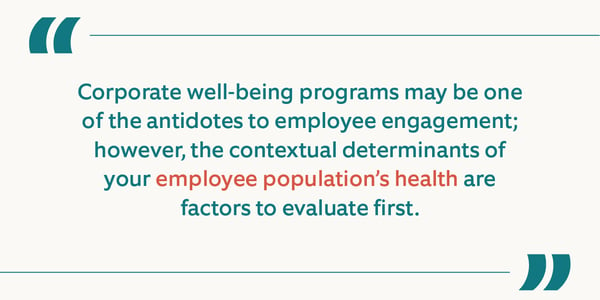Actionable Insights: Corporate Well-Being Programs as the Solution to the Great Resignation
Maybe. Maybe not.
In a Forbes article from December of 2021, the author Jeanne Meister outlined the dilemma for companies facing employees quitting jobs in record numbers, in what is being referred to as the “Great Resignation.” With over 11 million job openings to be filled, clearly, a key challenge for companies across virtually every industrial vertical is the recruitment and retention of qualified and motivated employees to fill this deepening void.
Equal to raising wages, Meister identifies well-being as a key criterion for taking and staying at a job. She breaks well-being into 5 key levers, based on a concept testing study conducted by her organization, Future Workplace, and payroll company, Paychex.

It was not a surprise to us that mental health well-being was high on the list, particularly “access to an Employee Assistance Program, mental health sessions with a therapist or coach, and mental health apps.” In any wellness program, be it in clinical healthcare or in the workplace, our research has indicated that how people are feeling, mentally and emotionally, significantly impacts how they manage to stay productive while facing the stresses of everyday life. This has never been truer as we enter the third year of an unprecedented global pandemic. Even telehealth access to mental help services, not always historically covered in regular health insurance plans, has become desirable and even necessary in a world where employees have become accustomed to much of their lives being lived remotely.
In times before COVID, human resources teams have often found it challenging to administer mental health well-being services, managing a balancing act between providing reliable and effective programs that avoid stigmatization of mental health needs, encouraging employee participation and measuring ROI. Particularly as it relates to privacy and the degree to which self-identification of having a mental health need might jeopardize employment, job candidates and current staffers may not see the benefits of mental well-being programs in the same light as their prospective or current employers. Understanding the root causes of stresses and tension in the workplace, and how mental health stressors at home can impact performance, as well as the myriad of cultural and/or social demographics of your workforce, will reveal the right components to consider in your mental health well-being initiatives with actionable insight. They aren’t always what you might assume, and they will differ based on the segment of your workforce you address and the Social Determinants of Health (SDoH) that population may face. With the stakes so high, building the right benefits packages and the communications plan to introduce them is key in terms of hiring and retaining a productive workplace.
There is no one size fits all. Knowledge workers who are working remotely have different considerations from employees who must be onsite, in factory or service roles, or in direct contact with customers. And the only way to assure understanding is to ask. The Society for Human Resource Management (SHRM) admonishes its members that the first step in establishing and setting up a wellness program is to: “Conduct employee surveys to evaluate the personal wellness interests and needs of employees. Surveying employees directly helps assess the current climate as to how a program might be received and what information employees are willing to share.”
In the Forbes article Meister also suggests that companies should “regularly take the pulse of your employee well-being benefits and identify the ones that matter most to each employee segment” with regular research and segmentation of your workforce population.
Corporate well-being programs may be one of the antidotes to employee engagement, however, the contextual determinants of your employee population’s health are factors to evaluate first.
Corporate well-being programs may be one of the antidotes to employee engagement; however, the contextual determinants of your employee population’s health are factors to evaluate first. Having a trusted, unbiased research partner, experienced in root cause analysis as well as the systems around and effects of SDoH, is key when identifying the features of a corporate wellness program that will fit the unique circumstances of your company’s workforce. Understanding the needs of current and prospective employees through concept testing will mean the programs you set up have the greatest potential to drive adoption, better outcomes, and ROI. Insights-based strategies for designing and implementing your mental health well-being programs can inform your employee communications regarding new benefits so they will hit the right note as you introduce them.
With over a decade of experience studying the intersection of health, well-being, social and structural determinants, and human behavior, Simply Strategy is uniquely positioned to evaluate your employee population and help you create well-being programs that will have the greatest potential to attract and sustain your distinctive employee population by implementing simple strategies. Let us help you uncover the actionable insights that will guide you through these challenging times, and into a better future.

